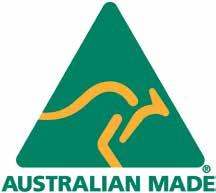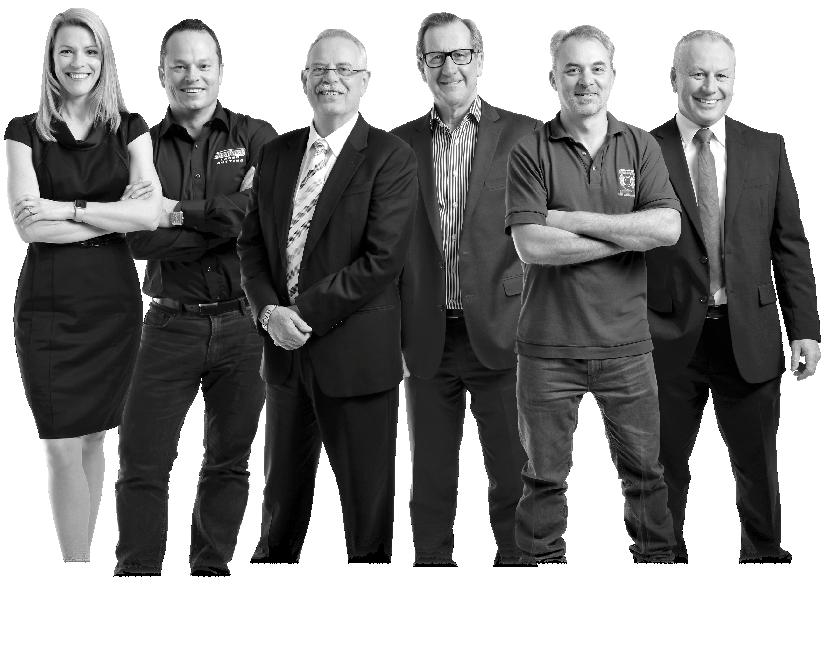
13 minute read
ONE ON ONE
from AMT AUG/SEPT 2020
by AMTIL
Ben Lazzaro is the Chief Executive Officer of the Australian Made Campaign Limited. He spoke to William Poole.
AMT: Tell us firstly about the Australian Made Campaign and its objectives. Ben Lazzaro: The Aussie Made Campaign’s remit is to administer and promote the famous Australian Made, Australian Grown logo, the green and gold kangaroo. That’s everything from compliance, to ensure that products that carry the logo comply with the criteria, through to promoting the brand and all the products that carry the logo. Essentially we’re running what’s called a country of origin certification trademark. It’s the only one in Australia. The logo itself has been around since 1986. Our organisation was established in 1999 by our governing members, which are the Australian Chamber of Commerce, the state and territory chambers of commerce, as well as the National Farmers Federation. So we have links into the business community and to the agricultural sector. Being a certification trademark, the Australian Made brand is governed by a set of criteria that products need to meet in order to ensure compliance. And that’s a big part of what we do. We have a compliance team that ensures the products that apply to use the logo meet those criteria based on Australian consumer law. This is where your average consumer would probably just glaze over, which would be quite right, because you don’t want to know how a watch works, you just want to know the time, and that’s what this brand does to some extent. When a consumer or business sees this product, they know that a third party has done the appropriate checks to ensure that it meets the Australian Made criteria set out in Australian consumer law. That means it satisfies what’s called a substantial transformation test, which essentially means the finished product is new in identity and in essential character to that of its imported or potentially imported input components. A very simple example is you can make a cake out of five ingredients that are all imported, but you turn those imported ingredients into a cake. That cake has been determined to be substantively transformed and therefore can be sold as an Australian-made cake. That is a very simplified version obviously, and with AMT’s audience it becomes more and more complicated and detailed with some of the manufacturing processes that our team would deal with. But that’s essentially the way we try to explain it. Another part of our job is policing. We make sure we maintain the integrity of the Australian Made logo. We run our own auditing processes. The best policeman is the competitor, so a lot of the time if someone’s misusing the logo, then it will be another logo user or a competitor, or a very eagle-eyed consumer that will report misuse. We follow up on every single issue that’s brought to us, and we go out and do our own checks as well.
So that’s a big part of what we do, which is also testament to why the logo enjoys a wonderful reputation, which we get (market research company) Roy Morgan to measure regularly. The Australian Made logo is recognised by 99% of Australians and trusted by 88%. And that second one is the one that we were most proud of, because our job is to make sure this logo makes the Australian connection instantly and clearly. That’s its prime job, that’s its role. We want to make sure that it makes the Aussie connection, it’s recognised, and most importantly it’s trusted, in that the products that carry the brand are indeed Australian. It evokes other attributes, of course; being Australian is positive in most contexts. And recently we did some more research and 84% of consumers associate the brand with jobs. And in the current environment with COVID-19, these things have never been more important, particularly jobs. Buying Aussie, there’s a direct correlation there with jobs. AMT: And how much clout does the Australian Made logo have internationally? For companies that are exporting, how much value is derived from the fact that those products are made in Australia? BL: Australia is viewed very positively overseas. In Asia, for example, we have a wonderful reputation for our clean green environment, our high standard of manufacturing; we’re known for quality, and the logo conveys a lot of those attributes. We did some research in China, and for many years now, we’ve been hearing about the 300 million middle-class in China who have an appetite for Aussie products, and of course who have the disposable income to buy them. When we did some research in China back in 2017, we found that 70% of shoppers that fell into that middle-class category knew that the brand was Australian – with products that carried our logo they made the Australian connection. So our brand, and Brand Australia in general, are certainly very highly regarded in that market. Now let’s not forget the US are also there, Europe’s there, all the other countries are there trying to sell products there as well, but there is absolutely opportunity overseas. I should point out we’re a not-for-profit organisation funded by licence fees. However AMCL recently secured a $5m Federal Government grant to promote the famous Australian Made logo in key export markets, as well as establishing trade mark registrations in the United Kingdom, the European Union and Canada. That’s become increasingly difficult in recent times of course, but there’s a lot of planning going on right now. So what you’ll see is a lot of online activations in the first instance. And over the next three years, we’re aiming to provide Australia Made logo users with more opportunities to promote Aussie products in export markets.
AMT: Obviously you’ve got impressive levels of recognition and trust among the public, but when it comes to getting people to take that next step and really embrace Australian-made goods, what are the obstacles to that? BL: It’s always an issue to some degree. When we’re asked, we always say we want to do the right thing, the thing that contributes back to our local community and our society. But of course, when push comes to shove, when we get to the cash register, people are ultimately going to vote with their wallets. Intention doesn’t always translate into practice. And that has always been a challenge for any kind of buy-local initiative. But what we are finding is quite interesting: even before COVID-19, we were finding that a lot of the things that the younger demographic in particular were interested in were attributes that often went hand-in-hand with Aussie products. So they’re interested in ethical production, they’re interested in sustainability. Well those are all attributes associated with a lot of Aussie-made products. So what we’ve done in recent times is we’ve been changing the way that we talk about that. In our marketing messaging, for example, we might not just go out there with a very simplified “Buy Aussie” message. We would be more targeted and try to talk to various demographics about the things that are going to hit with them. So we have to be part of the solution by changing the way we talk about being Aussie. Continued next page


Because long gone are the days where we were just talking about the auto industry and some of the more traditional things made here, such as food products. We’re making all sorts of new and interesting products here, a lot of bespoke, specialised products that might not have the mass market initially, but might be very appealing – particularly among younger demographics – as something that is unique or that is not mass-produced. And that’s where a lot of Aussie manufacturers are quite good. When you look into the more industrial sector, even though we’re not making cars anymore, we are making trucks, trailers, tankers – all that stuff is still being made here. At the Australian Made Campaign, we’re quite proud of our relationship with Volvo Trucks. They’re still producing Volvo and Mack trucks up in Queensland. They’ve got trucks rolling around Australia with the Australian Made green and gold badging all over them. In fact, we did a launch with them when they came on board and they’ve had orders for more of those badged trucks. I think there’s about six or eight of them rolling around at the moment with the green and gold paint all over them. Australian industry is also getting into battery production. Over in South Australia, Sonnen Australia has taken up residence in one of the old automotive factories, rehired former automotive workers, repurposed the facility and are now making their battery systems for the home where you store solar energy. Then there’s all the 3D printing initiatives that are coming out. And who knows what will happen with electric vehicles, whether we can get some of that back here. I read just the other day about a company that is launching here, H2X, to develop and manufacture electric vehicles in Australia. So manufacturing here in Australia… it’s just evolving. AMT: The COVID-19 crisis has certainly brought a lot of public focus on our overdependence on international supply chains and the need for local production capability. What do you think the big lessons have been? BL: Well we saw with COVID-19 that it was Australia’s manufacturers that retooled overnight and changed dramatically what they were doing to help start making the emergency equipment that we so desperately needed. It just demonstrated what we can do with a moment’s notice. Imagine the capacity of what we could do with a bit more planning and a bit more foresight, maybe some additional support from all the relevant groups. It’s not something you can just turn the tap on, and there needs to be a lot of planning, but we’ve got quite a resource on our doorstep. And that was really illustrated when we needed it. They were the guys that came to the rescue and continue to do so. I think that needs to be expanded, beyond just those items of selfsufficiency. Yes, we’ve got to make sure we have certain things on hand more readily in case this happens again. But if we can do that, why can’t we do the other things? I think COVID-19 has clearly opened our eyes to the imbalance between locally produced products and the imports that we’ve grown comfortable with. I think now more than ever it’s time to address that imbalance. We’re practical about this; we’re not silly. You’re always going to require imports. There’s going to be things that we’re always going to have to bring in. Any economy works best with balance. But I think there’s been an imbalance for some time, and it’s unfortunate that it takes milestone events like this to open our eyes a little bit. And everyone from those in business through to your average consumer have started to really acknowledge the benefits of buying local. That’s one thing that’s clearly been highlighted. For example our engagement on our digital platforms with consumers has gone through the roof. We’ve always had a very strong level of engagement on our social media platforms, but in the last couple of months it’s gone up 300%. We have the biggest online directory of certified Aussie-made products, and the traffic to that has gone up two and a half times in the last couple of months as well. And the phone calls and email enquiries from consumers have all gone through the roof. There’s a huge appetite out there for the products, and that is not being unnoticed by business, because applications to use the Australian Made logo have also increased – we’ve seen a fourfold increase over the last few months. So we are in a lucky position from a business point of view in that we have never been busier and relish the opportunity to welcome these new businesses on board. While there are certainly businesses doing it tough, there are others that are seeing that now is the time to really leverage what we would describe as their Australian advantage. It’s always been positive to be Aussie, and even more so now. AMT: And do you think this shift in the public mood can sustain itself as the crisis abates and everything opens up again, or will it snap back to business as usual? BL: There’ll always be a percentage of the population that is going to be price-driven, and that’s always going to be the case. But from what we’ve seen, I’d be staggered if we didn’t see the needle move back towards buying Australian in a significant way.
The challenge there is obviously to make sure that the choice is there, that the products can be found, that they’re clearly identified as Australian. We’ve got to make it easy for the consumers. So if you’re a business or a retailer that’s selling Aussie products, I think with a collective effort we can make sure we clearly identify where those products are and give consumers every opportunity to exercise that preference for Aussie that they keep telling us they have. Ultimately time will tell, but I am confident we will see that dial move in a more positive direction. You’re never going to get everyone, but I think we’ll increase the amount of people that are seeking out and prioritising Aussie products for sure. AMT: And how do companies go about engaging with the Campaign and getting themselves certified? BL: They can certainly call the office and have a chat with someone to find out if it’s right for them, or they can simply go online at www. australianmade.com.au. It’s a very short online application process, our compliance team gets in touch, it goes through the approval process, and then we issue artwork and away you go. And it’s a very modest licence fee to use the logo, as little as $300 up to a maximum of $25,000 a year. We’re here to help Aussie manufacturers, we want to add value where we can. The logo is registered across all 34 classes of goods in Australia, so our team has to get pretty up to speed on a range of different sectors. You know, the compliance team is assessing a mattress one day, then a face cream the next, and then a Volvo truck. So it certainly keeps it interesting. AMT: Tell us about your background and how you ended up with the Campaign. BL: I was an engineer for a number of years. I worked in the oil & gas sector, and then I worked in a marketing & communications consultancy that serviced engineering-based companies. So that role required someone that understood the technology, but also had the marketing and comms capacity. I worked there for a long period, then I transitioned into a marketing role here in Australia Made. So again I was working in that sort of technical and industrial area, with an understanding of marketing and comms. I worked my way up to Deputy CEO, and I’ve been the boss for two years now. The role is quite diverse. We’re a small business, so it’s often all hands on deck, depending on what’s happening. I feel very lucky to be in this position, and hopefully we’re adding value to our licensees and are other stakeholders. www.australianmade.com.au
Why am I a member of AMTIL?


Aside from supporting our industry through membership of our peak body, I find the developed network of like-minded companies and individuals invaluable. As an engineering and manufacturing group we all face similar challenges. Often when issues arise I am able to pick up the phone and discuss a problem or get advice from other members who all share our common values and goals of seeing Australian manufacturing prosper.

Peter Sutton, Sutton Tools
Since 1999, AMTIL has been connecting business, informing of opportunities and growing the manufacturing community.










